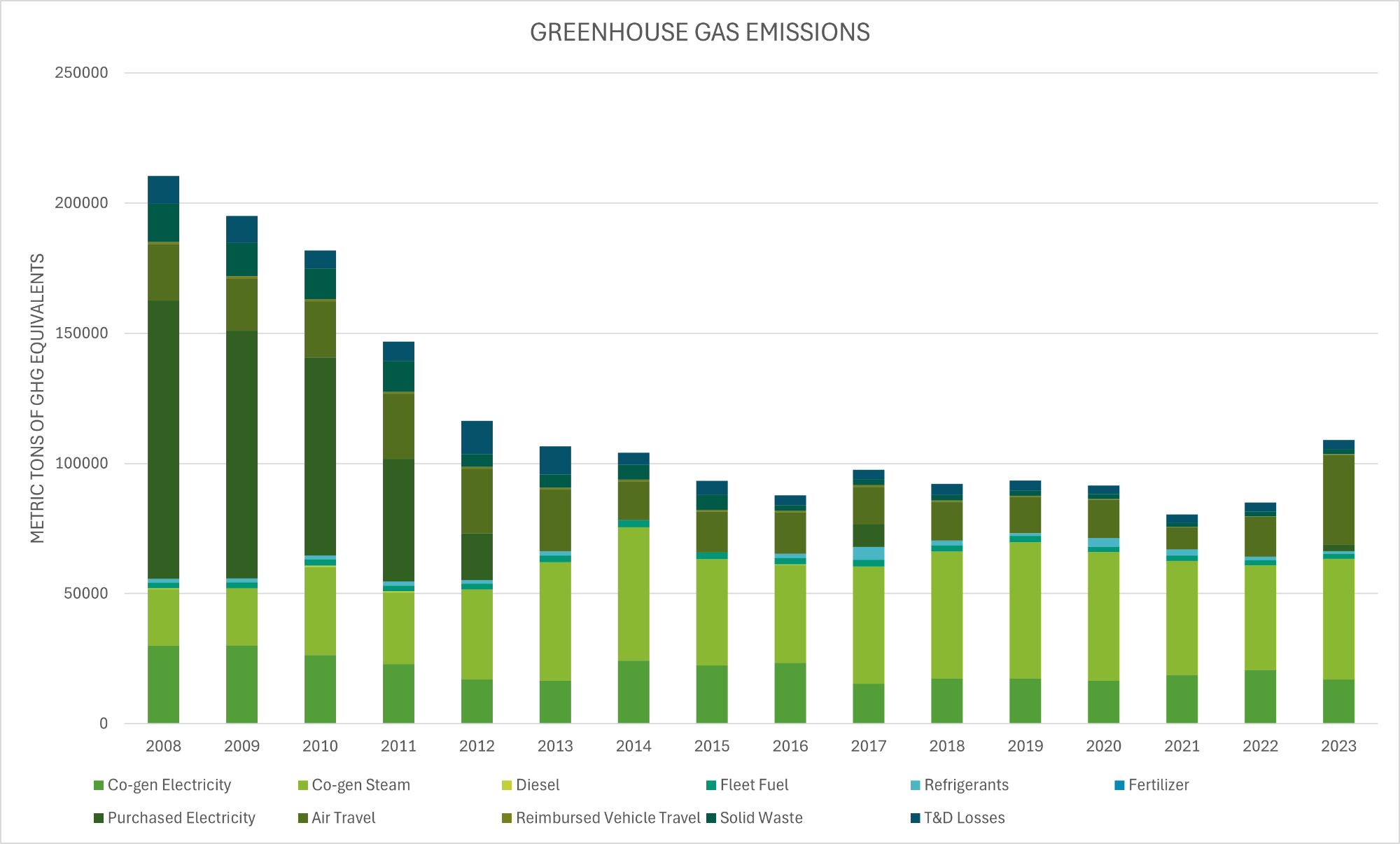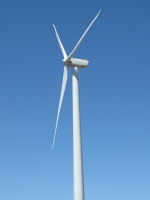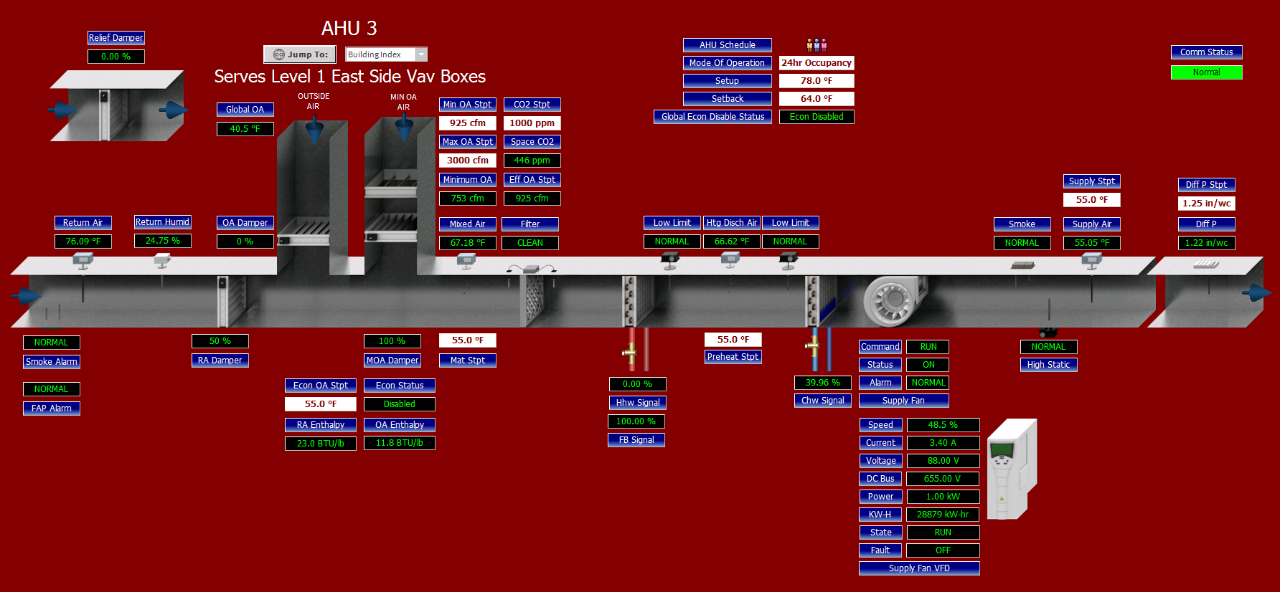Over the time period of 2008 to 2022, the Norman campus has reduced greenhouse gas equivalent emissions by approximately 50% It is the university’s objective to achieve climate neutrality by the year 2050.
Energy Management
Energy management has been a long standing commitment of the University of Oklahoma's. Energy conservation efforts and the procurement of electricity from renewable sources has enabled the University to reduce energy consumption per square foot by 15% (compared to Fiscal Year 2012 baseline levels) and emissions by approximately 50% (compared to Fiscal Year 2008 baseline levels).
The University meters electricity, natural gas, steam, chilled water, and domestic water. The University initiated metering improvement plans in 2012 to improve the metering infrastructure on campus and provide building-level utility data across campus. Meters on the electric distribution system were upgraded to smart meters with an automated metering infrastructure in 2013. The University finished installing smart chilled water meters and smart steam meters in 2020. The University initiated a central smart meter platform to upgrade to all electric, non-potable water, domestic water, and natural gas metering with a current target completion in 2025. Metering data is collected, recorded and analyzed to form the basis of energy efficiency improvements and other capital expenditures to reduce utility usage. As the metering inventory project has been implemented, malfunctioning existing meters have also been identified and replaced. Smart meters have been integrated with a web-based automated metering platform which will collect real-time meter data, giving better insight into building and utility system demand.
Email save.energy@ou.edu for questions related to campus energy.
Emissions

Wind Power Commitment
On September 10, 2008, the University signed an agreement with Oklahoma Gas & Electric Company (OG&E) to acquire 100% of our purchased electricity from renewable energy sources by 2013. This project was instrumental in enabling OG&E to build the OU Spirit Wind Farm – along with the required transmission lines to the grid – in northwestern Oklahoma. The 101 megawatt "OU Spirit" wind farm features 44 2.3 MW turbines.
Since entering into our power purchase program with OG&E, the University has purchased over 1.8 billion kilowatt-hours of renewable energy. Compared to regular electric service, choosing to purchase renewable energy has the greenhouse gas benefit equivalent of more than 780,000 metric tons of carbon dioxide equivalents.

What does that mean in terms of environmental benefits?
- Taking 185,000 gas-powered passenger vehicles off the road for 1 year.
- Forego the burning of 850 million pounds of coal.
- Planting 12.8 million tree seedlings (grown for a period of ten years).
- OR, preserving 5,000 acres of forest from conversion to cropland for 1 year.
As a result of the agreement, the University of Oklahoma currently ranks first in the Southeastern Conference and twelfth in the nation among higher education institutions in the Environmental Protection Agency’s Green Power Partnership. The University was honored by the EPA as the 2012 Green Power Partner of the Year.
Energy Conservation Measures
Generating Assets
In June 2012, OU substantially completed and commissioned Utility Plant Number Four (UP4), a new, state of the art cogeneration plant. UP4 was designed to more fully utilize the heat it generates, reducing emissions by 15%. It does this by efficiently capturing what would normally be waste heat and using it to generate steam.
HVAC, Chiller, and Boiler Upgrades
Recently, heating and cooling systems have been replaced at Catlett, McCarter Hall, Kraettli Apartments, Telecomm Maintenance Facility, Fine Arts Center, Union, Buchanan Hall, Two Partners Place, NC Building 366 and others.
LED Lighting Installations
Existing lighting has been retrofitted to LEDs at Catlett, Saxon Warehouse, the Union Parking Facility, the lower level of the Elm Street Parking Facility, Jones Art Center, Carpenter Hall, Sam Noble Museum, and Printing Services. Recently, LED fixtures were chosen for 35 newly installed street lights along Asp Avenue. In the fall of 2024, a pilot project to identify an LED retrofit option for existing campus T8 lights will be performed in the Facilities Management compound. Moving forward, new street and parking lot lights will be LED fixtures.
Interior Lighting and Occupancy Sensor Retrofits
The University replaced interior lighting with more efficient ballasts and lower wattage lighting; additionally, occupancy sensors were installed to avoid lighting unoccupied space.
Exterior Lighting Replacements
Existing University street lighting was retrofitted with more energy efficient ballasts and bulbs that reduce electricity consumption by fifty percent.
Vending Machine Mizers
Passive infrared sensors and smart controls power down vending machines when the surrounding area is vacant. Product cooling is maintained by periodic powering in user-specified intervals; and energy consumption can be reduced by 46%, typically saving $150 per machine annually.
Exit Sign Replacement
New photo luminescent, or glow-in-the-dark, exit signs have replaced battery operated or electric powered signs in study areas, hallways and classrooms.
Steam System Upgrades
Evaluated 330 existing steam traps and replaced 277 incorrectly sized, or non-working traps with properly sized traps.
Infrared Roof Scans and Roof Replacements
The University routinely scans facilities' roofs to identify are repair moisture trapped in roofing system. Moisture trapped in roofing systems reduces the roofs ability to insulate and leads to increased cooling and heating costs. These scans also allow the University to specifically target spending based on condition, rather than age of roof. Recently, roofs have been replaced at North Campus Building 210, Kaufman Hall, Carpenter Hall, Whitehand Hall, George Lynn Cross, Nuclear Engineering Laboratory, Felgar Hall and others.
Building Automated Controls
A direct digital control (DDC) building automation system (BAS) is utilized to monitor and regulate HVAC and lighting in approximately 100 buildings totaling over 7.3 million gross square feet of metered campus facilities. During occupied hours, the BAS allows inhabitants to adjust thermostats within a predetermined range. During warm periods, occupants are able to cool as low as 68 degrees Fahrenheit, and in cooler periods, occupants are able to heat as high as 74 degrees Fahrenheit. While there are established limits for heating and cooling temperatures, it is the intent of the BAS to provide comfortable settings to allow occupants to remain productive during regular business hours. During unoccupied periods, air temperatures are relaxed to 80 degrees in warm periods and to 55 degrees during cool periods. Additionally, the BAS schedules economizer systems, exterior lighting hours of operation and hot water reset schedules.


